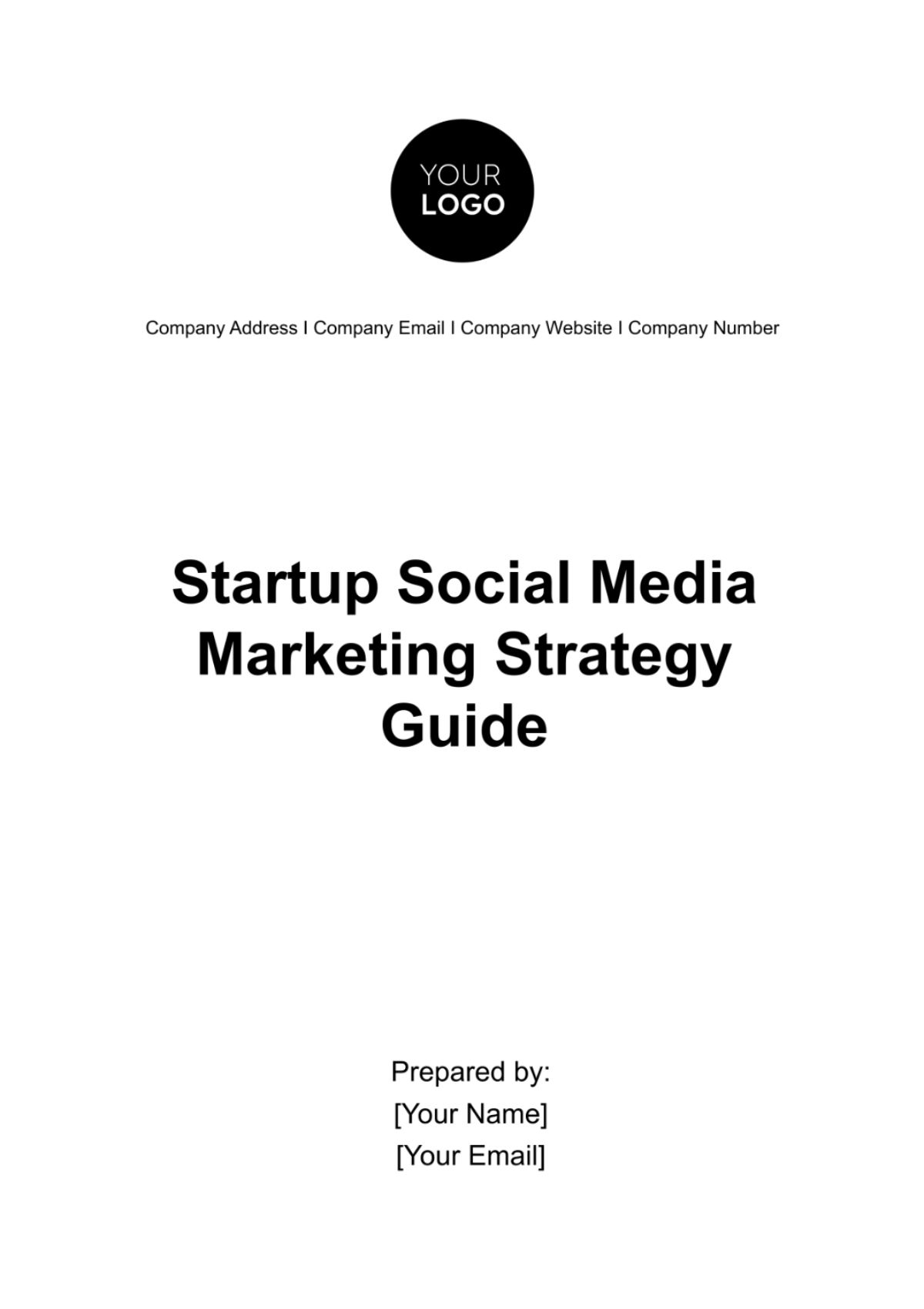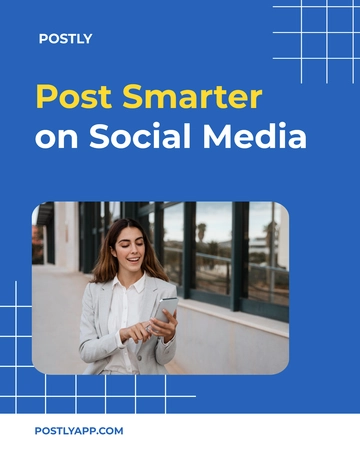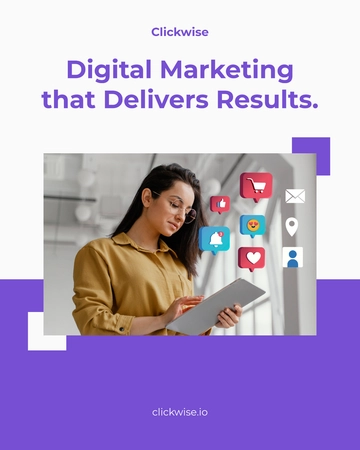Free Startup Social Media Marketing Strategy Guide

1. Introduction to Social Media Marketing Strategy
Social media has become an indispensable tool for startups to connect with their audience, build brand awareness, and drive business growth. In today's digital landscape, having a well-defined social media marketing strategy is not just advantageous but essential for staying competitive. By leveraging the power of social media platforms effectively, startups can reach a broader audience, engage with potential customers, and establish themselves as industry leaders.
Why Social Media Marketing Matters for Startups
1.1.1. Reach: Social media platforms provide startups with unparalleled reach, allowing them to connect with potential customers around the globe.
1.1.2. Brand Awareness: Building brand awareness is crucial for startups looking to establish themselves in a competitive market. Social media offers a cost-effective way to increase brand visibility and reach new audiences.
1.1.3. Engagement: Social media enables startups to engage directly with their audience, fostering relationships, and building trust and credibility.
1.1.4. Customer Insights: By actively participating in social media conversations, startups can gain valuable insights into customer preferences, behaviors, and trends.
1.1.5. Competitive Advantage: A well-executed social media marketing strategy can provide startups with a competitive edge by helping them stand out from the competition and differentiate their brand.
2. Understanding Your Target Audience
Before diving into social media marketing, startups must first understand who their target audience is and what motivates them. By gaining a deep understanding of their audience's needs, preferences, and pain points, startups can tailor their social media efforts to resonate with their target demographic effectively.
Methods for Understanding Your Target Audience
2.1.1. Market Research: Conduct comprehensive market research to identify your target audience's demographics, interests, and online behaviors. Use tools such as surveys, focus groups, and competitor analysis to gather valuable insights.
2.1.2. Buyer Personas: Develop detailed buyer personas that represent your ideal customers. Consider factors such as age, gender, location, job title, interests, challenges, and goals to create accurate and actionable personas.
Sample Buyer Persona Template
Persona Name | Age Range | Location | Job Title | Interests | Pain Points |
|---|---|---|---|---|---|
Sarah Thompson | 25-35 | Urban areas | Marketing Manager | Travel, Fitness | Limited budget for ads |
2.1.3. Social Listening: Monitor social media channels, forums, and online communities relevant to your industry to listen to conversations and gather insights into your audience's preferences, sentiments, and pain points.
2.1.4. Feedback and Surveys: Collect feedback from existing customers through surveys, polls, and direct communication channels. Use this feedback to identify areas for improvement and better understand customer needs and preferences.
By investing time and resources into understanding their target audience, startups can create more relevant and compelling social media content, engage with their audience more effectively, and ultimately drive business growth.
3. Setting SMART Goals
Setting specific, measurable, achievable, relevant, and time-bound (SMART) goals is crucial for guiding a startup's social media marketing efforts and measuring success effectively. By establishing clear objectives, startups can focus their resources and efforts on activities that align with their overall business goals and track their progress over time.
Guidelines for Setting SMART Goals
3.1.1. Specific: Clearly define the desired outcome of your social media marketing efforts. Instead of a vague goal like "increase brand awareness," a specific goal would be "increase brand mentions on Twitter by 20% within the next three months."
3.1.2. Measurable: Identify key performance indicators (KPIs) that will allow you to measure progress towards your goals. These may include metrics such as followers, engagement rate, website traffic, leads generated, or conversions.
3.1.3. Achievable: Ensure that your goals are realistic and attainable based on your startup's resources, capabilities, and market conditions. Set challenging but achievable targets that will motivate your team to strive for excellence.
3.1.4. Relevant: Align your social media goals with your startup's overall business objectives and marketing strategy. Every social media goal should contribute directly to achieving broader business goals, such as increasing sales, expanding market share, or launching a new product.
3.1.5. Time-bound: Set a specific timeframe for achieving your goals to create a sense of urgency and accountability. Whether it's a monthly, quarterly, or annual goal, having a deadline helps keep your team focused and on track.
Sample SMART Goals for a Startup
Goal | Description | KPIs | Timeline |
|---|---|---|---|
Increase Brand Awareness | Increase brand mentions on social media by [00%] | Brand mentions | Q1 2024 |
Drive Website Traffic | Increase website traffic from social media by [00%] | Website traffic | Q2 2024 |
4. Choosing the Right Social Media Platforms
With numerous social media platforms available, it's essential for startups to select the ones that align best with their target audience, business goals, and resources. By focusing on platforms where their audience is most active and engaged, startups can maximize the impact of their social media marketing efforts and achieve better results.
Factors to Consider When Choosing Social Media Platforms
4.1.1. Target Audience: Identify the demographics, interests, and online behaviors of your target audience to determine which social media platforms they are most likely to use.
4.1.2. Business Goals: Consider your startup's objectives and what you aim to achieve through social media marketing. Different platforms offer unique features and functionalities that may align better with specific goals, such as brand awareness, lead generation, or customer engagement.
4.1.3. Content Strategy: Evaluate the types of content you plan to create and share on social media. Some platforms are more conducive to visual content (e.g., Instagram, Pinterest), while others are better suited for long-form content (e.g., LinkedIn, Medium).
4.1.4. Resources and Budget: Assess your startup's resources, including time, manpower, and budget, available for managing and promoting your social media presence. Choose platforms that you can effectively manage and invest in based on your resource constraints.
Comparison of Social Media Platforms
Platform | Description | Target Audience | Key Features |
|---|---|---|---|
Largest social network with diverse demographics | Broad audience | Business Pages, Ads, Groups | |
Visual-centric platform for photos and videos | Millennials, Gen Z | Stories, IGTV, Reels | |
By carefully evaluating these factors and conducting research on platform demographics and features, startups can make informed decisions about which social media platforms to prioritize in their marketing strategy. This targeted approach ensures that resources are allocated efficiently and efforts are focused on platforms where they are most likely to yield positive results.
5. Content Strategy and Creation
Creating compelling and valuable content is at the core of any successful social media marketing strategy. Startups need to develop a content strategy that resonates with their target audience, reinforces their brand identity, and drives engagement and conversions. By delivering relevant and high-quality content consistently, startups can attract and retain followers, establish thought leadership, and ultimately drive business growth.
Components of a Content Strategy
5.1.1. Audience Research: Conduct thorough research to understand your target audience's interests, preferences, and pain points. Use this insight to tailor your content to their needs and motivations effectively.
5.1.2. Content Calendar: Develop a content calendar to plan and organize your social media content ahead of time. Include key dates, holidays, and events relevant to your industry to ensure timely and relevant content delivery.
5.1.3. Content Types: Experiment with various types of content, including text posts, images, videos, infographics, and user-generated content, to keep your audience engaged and interested.
5.1.4. Tone and Voice: Define your brand's tone and voice on social media to ensure consistency and authenticity in your messaging. Consider your target audience and brand personality when determining the appropriate tone for your content.
5.1.5. Engagement Strategies: Encourage audience engagement by asking questions, conducting polls, running contests, and responding promptly to comments and messages. Foster a sense of community and dialogue around your brand.
Sample Content Calendar
Date | Content Theme | Content Type | Platform | Engagement Strategy |
|---|---|---|---|---|
Feb 14, 2050 | Valentine's Day | Image | Ask followers to share their favorite love quotes | |
Feb 17, 2024 | Product Spotlight | Video | Host a live Q&A session with the product team | |
6. Engagement and Community Building
Building a strong and engaged community around your startup is essential for fostering brand loyalty, advocacy, and long-term relationships with your audience. By actively engaging with your followers, responding to their feedback, and providing valuable content and support, startups can cultivate a dedicated fan base that advocates for their brand and drives organic growth.
Strategies for Engagement and Community Building
6.1.1. Respond to Comments and Messages: Regularly monitor your social media channels and respond promptly to comments, messages, and mentions. Show appreciation for positive feedback and address any concerns or questions raised by your audience.
6.1.2. Foster User-Generated Content: Encourage your followers to create and share content related to your brand, products, or services. Highlight user-generated content on your social media channels to showcase your community and build brand authenticity.
6.1.3. Host Interactive Events: Organize live Q&A sessions, webinars, Twitter chats, or Facebook Live events to engage directly with your audience in real-time. Use these opportunities to share valuable insights, answer questions, and connect with your community on a personal level.
6.1.4. Create Exclusive Groups or Communities: Establish private Facebook groups, LinkedIn groups, or Discord servers where your most dedicated fans can connect, share ideas, and interact with your team and other community members.
6.1.5. Collaborate with Influencers: Partner with influencers or micro-influencers in your niche to reach new audiences and leverage their credibility and influence to promote your brand and products authentically.
By prioritizing engagement and community building efforts on social media, startups can nurture relationships with their audience, build brand trust and loyalty, and ultimately drive positive word-of-mouth and referrals.
7. Leveraging Paid Advertising
Paid advertising on social media platforms can be a powerful tool for startups to amplify their reach, target specific audience segments, and drive targeted traffic to their website or landing pages. By investing in paid advertising strategically, startups can maximize their return on investment (ROI) and achieve their marketing objectives more effectively.
Types of Paid Advertising Options
7.1.1. Social Media Ads: Platforms like Facebook, Instagram, Twitter, and LinkedIn offer various ad formats, including image ads, video ads, carousel ads, and sponsored content. These ads can be highly targeted based on demographics, interests, behavior, and other criteria to reach the most relevant audience.
7.1.2. Paid Influencer Collaborations: Partnering with influencers or micro-influencers to promote your products or services can be an effective form of paid advertising. Influencers can help you reach their followers authentically and leverage their credibility and influence to drive conversions.
7.1.3. Sponsored Content: Collaborate with popular social media accounts or publications in your industry to sponsor content relevant to your target audience. Sponsored posts, articles, or videos can help you reach a larger audience and generate brand awareness and engagement.
Budgeting Considerations
7.2.1. Determine your advertising budget based on your overall marketing objectives, target audience size, and the competitiveness of your industry. Allocate your budget strategically across different platforms and campaigns to maximize reach and impact.
7.2.2. Monitor your advertising spend closely and adjust your budget allocation based on the performance of your campaigns. Allocate more budget to campaigns that are driving positive results and scale back or reallocate budget from underperforming campaigns.
Tips for Maximizing ROI
7.3.1. Set clear objectives and key performance indicators (KPIs) for your paid advertising campaigns to measure success effectively. Whether it's increasing website traffic, generating leads, or driving sales, define specific goals to guide your advertising efforts.
7.3.2. Test different ad creatives, messaging, targeting options, and ad formats to identify what resonates best with your target audience. Continuously optimize your ads based on performance data to improve ROI over time.
7.3.3. Implement tracking and attribution mechanisms to monitor the impact of your paid advertising efforts on key business metrics, such as website conversions, lead generation, and customer acquisition cost (CAC). Use this data to refine your targeting and messaging and optimize your ad spend allocation.
8. Analytics and Performance Tracking
Monitoring and analyzing the performance of your social media marketing efforts is critical for measuring ROI, identifying areas for improvement, and making data-driven decisions to optimize your strategy. By leveraging analytics tools and tracking key metrics, startups can gain valuable insights into their audience's behavior, preferences, and engagement with their content.
Key Metrics to Track
8.1.1. Engagement Metrics: Monitor metrics such as likes, comments, shares, retweets, and click-through rates to measure the level of engagement and interaction with your social media content. High engagement indicates that your content resonates with your audience and is driving meaningful interactions.
8.1.2. Reach and Impressions: Track metrics related to the reach and impressions of your social media posts to assess the visibility and exposure of your content. Analyze how many users are seeing your content and how often it's being displayed in their feeds.
8.1.3. Conversion Metrics: Measure the effectiveness of your social media marketing efforts in driving conversions, such as website visits, leads generated, and sales attributed to social media referrals. Track conversion rates and customer acquisition cost (CAC) to evaluate ROI and optimize your campaigns accordingly.
Tools for Analytics
8.2.1. Social Media Analytics Platforms: Utilize built-in analytics tools provided by social media platforms, such as Facebook Insights, Instagram Insights, Twitter Analytics, and LinkedIn Analytics. These tools offer valuable data on audience demographics, engagement metrics, and performance of your posts and ads.
8.2.2. Third-Party Analytics Tools: Consider using third-party analytics tools and software, such as Google Analytics, Hootsuite Analytics, Buffer Analytics, or Sprout Social, for more comprehensive reporting and analysis of your social media marketing efforts across multiple platforms.
Interpreting Data and Making Data-Driven Decisions
8.3.1. Regularly review and analyze your social media performance data to identify trends, patterns, and areas for improvement. Look for correlations between different metrics and identify factors that may be influencing your results.
8.3.2. Use data insights to inform your content strategy, ad targeting, posting frequency, and other aspects of your social media marketing strategy. Test hypotheses, experiment with different approaches, and iterate based on performance data to optimize your results over time.
8.3.3. Share key findings and insights with your team and stakeholders to facilitate collaboration and alignment around your social media marketing strategy. Use data-driven reports and presentations to communicate the impact of your efforts and make informed decisions about resource allocation and strategy adjustments.
By leveraging analytics and performance tracking effectively, startups can gain valuable insights into their social media marketing efforts, measure the impact of their activities, and make informed decisions to optimize their strategy and drive business growth.
9. Iteration and Optimization
Continuous iteration and optimization are essential for maintaining a successful social media marketing strategy. Startups must be proactive in evaluating their performance, identifying areas for improvement, and implementing changes to optimize their results over time. By embracing a culture of experimentation and learning, startups can stay agile and responsive to evolving market dynamics and customer preferences.
Continuous Improvement Process
9.1.1. Performance Analysis: Regularly review and analyze key performance metrics to assess the effectiveness of your social media marketing efforts. Identify trends, patterns, and outliers that can provide insights into what's working well and what areas need improvement.
9.1.2. A/B Testing: Conduct A/B tests to compare different variations of your content, ad creatives, targeting options, and messaging to determine which performs better with your audience. Test one variable at a time and measure the impact on key metrics to make data-driven decisions.
9.1.3. Feedback Loop: Solicit feedback from your audience through surveys, polls, and direct communication channels. Pay attention to comments, messages, and mentions to understand their preferences, expectations, and pain points. Use this feedback to refine your strategy and better meet their needs.
9.1.4. Competitive Analysis: Keep an eye on your competitors' social media activities and performance to benchmark your performance and identify opportunities for differentiation. Analyze their content, engagement strategies, and ad campaigns to gain inspiration and stay ahead of the curve.
Optimization Strategies
9.2.1. Content Optimization: Continuously refine your content strategy based on performance data and audience feedback. Experiment with different content formats, topics, and posting schedules to find the optimal mix that resonates with your audience and drives engagement.
9.2.2. Ad Campaign Optimization: Monitor the performance of your paid advertising campaigns closely and make adjustments to optimize their effectiveness. Tweak targeting options, ad creatives, and messaging based on performance data to improve ROI and achieve better results.
9.2.3. Audience Segmentation: Segment your audience based on demographics, interests, behaviors, and engagement levels to deliver more personalized and relevant content. Tailor your messaging and targeting strategies to different audience segments to maximize engagement and conversion rates.
9.2.4. Performance Tracking: Implement robust tracking and analytics mechanisms to monitor the impact of your optimization efforts on key metrics. Track changes in performance over time and attribute improvements to specific optimization tactics to inform future iterations.
10. Conclusion
A proactive approach to iteration and optimization is crucial for maintaining a competitive edge in the ever-evolving landscape of social media marketing. By continuously evaluating performance, experimenting with new approaches, and learning from both successes and failures, startups can refine their social media strategy, maximize their impact, and drive sustainable growth over the long term.
For further assistance or personalized guidance on optimizing your startup's social media marketing strategy, don't hesitate to reach out to [Your Company Name] at [Your Company Email].
- 100% Customizable, free editor
- Access 1 Million+ Templates, photo’s & graphics
- Download or share as a template
- Click and replace photos, graphics, text, backgrounds
- Resize, crop, AI write & more
- Access advanced editor
Introducing the Startup Social Media Marketing Strategy Guide Template available on Template.net. This comprehensive guide is fully editable and customizable, empowering startups to develop effective social media marketing strategies tailored to their unique goals and audience. With our user-friendly Ai Editor Tool, crafting a winning social media plan has never been easier. Unlock the potential of your startup's online presence today!
You may also like
- Instagram Ad
- Instagram Banner
- Instagram Frame
- Instagram Post
- Instagram Profile Picture
- Instagram Story
- Instagram Story Highlights
- Twitter Ad
- Twitter Header
- Twitter Post
- LinkedIn Photo
- Linkedin Post
- YouTube
- Youtube Ad
- Youtube Banner
- YouTube Channel Art
- YouTube End Screen
- Youtube Profile Photo
- YouTube Thumbnail
- Facebook Ad
- Facebook Cover
- Facebook Post
- Facebook Profile Frame
- Facebook Profile Photo
- Twitch Offline Banner
- Linkedin Banner
- Twitch Overlay
- Whatsapp Status
- Reddit Banner
- Social Media Banner
- Social Media Clipart
- Social Media Plan
- Social Media Contract
- Social Media Planner
- Social Media Report
- Social Media Agreement
- Social Media Business Card
- Social Media Proposal
- Social Media Presentation





























